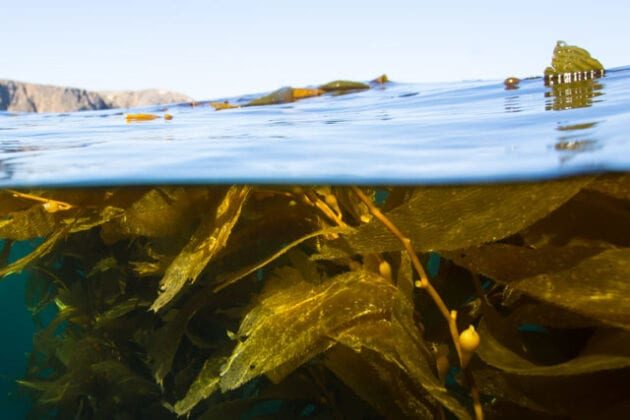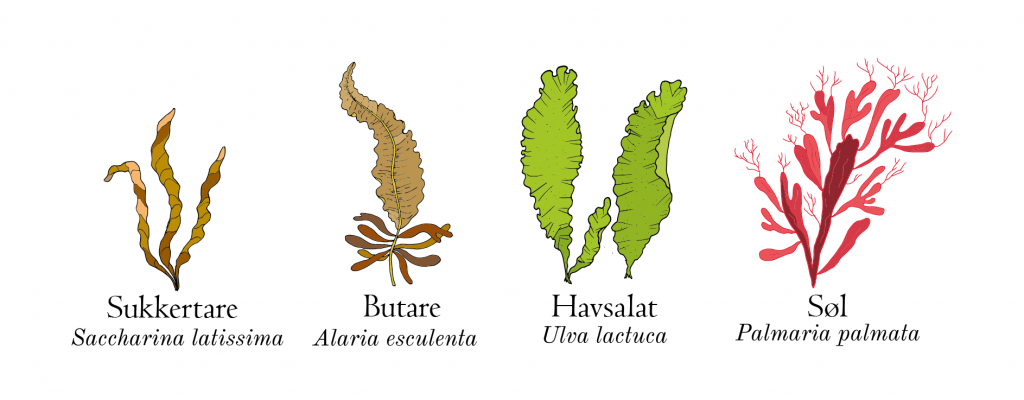Good to know about food-grade kelp

The kelp that grows along our coast is an excellent ingredient and flavour enhancer that can add an extra touch of the sea to your meal while also providing you with important nutrients.
In the same way that we forage for berries and mushrooms in the forest, we can also make use of the kelp forest along the coast. This is what our ancestors did, but the art of cooking with kelp has largely been forgotten.
Would you like to try eating kelp that you have picked yourself but are unsure what is safe to pick and how to do it? Here are some facts and tips that can help you on your way.
What kind of kelp can I eat?
There are many different species of kelp that can be eaten, but those that are best used in food are
- Sugar kelp: Large brown algae that forms forests along the entire coast, as well as around Svalbard.
- Dabberlocks (winged kelp): Brown algae found along the coast from Mandal to Finnmark, as well as around Svalbard.
- Sea lettuce: Green algae, common along the entire coast.
- Dulse: Red algae, common along the entire coast.
The best time for harvesting kelp is during spring, when there are fresh new leaves without much additional growth from other marine lifeforms.
You can use guides and apps on your phone if you’re not sure what the different species look like for example:

Is kelp safe to eat?
The vast majority of kelp is safe to eat, but not everything tastes great.
Some kelp species may contain a little too much iodine. Some iodine is very healthy, but too much is bad for you.
Kelp is an excellent substitute for salt in cooking, allowing you to reduce your salt intake.

What does it taste like?
Taste is the most important aspect of kelp, in addition to its ability to enhance other flavours. The various species of kelp all taste a little different.
The red algae, dulse, has a strong flavour reminiscent of bacon. Sea lettuce is milder on taste, while sugar kelp and winged kelp provide a salty sea flavour. They also have umami – the “fifth taste” – which acts as a flavour enhancer for other food products, allowing their flavours to shine when eaten together with kelp.
However, the taste ultimately depends on how it is prepared. When kelp is boiled, the amino acids (glutamic acid and alanine) that contribute to umami disappear. You will find more information about cooking kelp below.
Where can I find edible kelp?
Kelp grows in shallow rather than deep water, but always far enough off the coast to keep it completely submerged. This means that the best way to get it is to wear a wetsuit and dive a short way. It requires light, as its survival is wholly dependent on photosynthesis.
Find an area with fresh, clear water. Be wary of pollution and avoid harvesting in areas where there is runoff from agriculture or industry. A great tip is to observe the mussel warnings – official information about where not to gather mussels. If it is safe to gather mussels, it is also safe to pick seaweed and kelp.
If you do not want to go into the water, you can also buy kelp from professional kelp growers. Several of these have online shops and provide recipes together with their products.
How do I harvest it?
Bring scissors for cutting and ideally a net which you can strap around your waist to collect the kelp in. Sugar kelp, finger kelp and dabberlocks thrive where there are strong currents and waves, so be careful not to get swept away by the current.
Cut off the top half of the plant using scissors so that it can grow out again. You should not pull out the entire plant including the stem and foot.
Choose good, healthy leaves with little growth from other marine species and inspect the leaves to ensure that they are whole and healthy and that they have not been grazed on – there are several ocean dwellers that like to eat kelp.
The best, healthiest shoots are found during spring.
Is kelp healthy?
Kelp contains important minerals, antioxidants and vitamin B and C. Some species of kelp also contain protein, polyunsaturated fatty acids and fibre.
Kelp is especially rich in iodine, which is a nutrient that we need but that many people struggle to get enough of. However, too much iodine is unhealthy, and it may be unwise to consume large quantities.
Iodine levels are substantially reduced by boiling in water and high levels of iodine are already removed at 60°C without significantly reducing the levels of other nutrients.
How do I prepare kelp?
Det vanligste er å tørke taren før den spises, men du har også andre alternativer:It is most common to dry the kelp before it is eaten but there are other options too:
- Grill: Place the kelp on the barbecue, perhaps around a piece of fish or other food. If you barbecue it on its own you will achieve a crisp, tasty snack that is much healthier than potato crisps.
- Boil: Boil, drain and use it as an ingredient in soups.
- Dry: Hang it from the ceiling on a cord. When it is nice and crisp, you can eat it as a snack or crush it and sprinkle it over your food as you would a spice. It goes especially well with fish dishes and in soups.
When brown kelp is heated, the colour changes from shades of brown to a healthy green.
When you buy cultivated kelp, it often comes with a recipe.
Cultivated kelp can be bought online or in selected shops.
Why should we eat kelp?
Two thirds of the surface of the earth is covered by water. We could harvest so much more from this field of blue. Kelp is used in animal feed, as a fertiliser and for bioenergy. But as the world’s population continuously grows, there are more and more people in need of food – and the kelp forest can provide many excellent nutrients.
Research on kelp
Nofima food scientists are working to ensure that everyone has access to sustainable food. This involves research on how to cultivate and prepare kelp so that it can be a safe and beneficial part of the range of food products on offer.
As part of the “TastyKelp” project, we are systematically testing various cooking methods and finding out what happens to flavour, appearance and nutritional content.
Kontaktperson
Research areas
Food from new sources
Topics
Low trophic species
